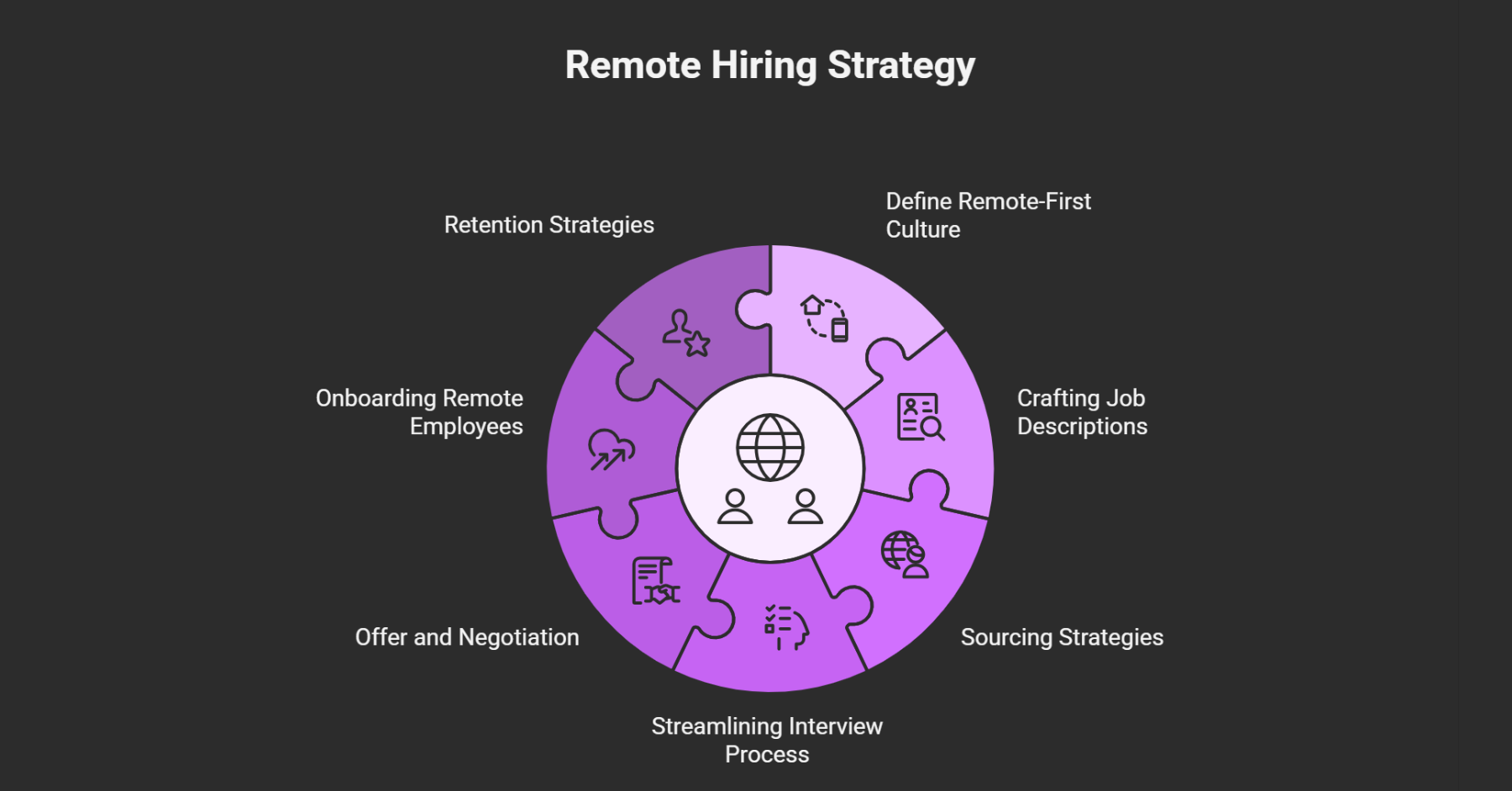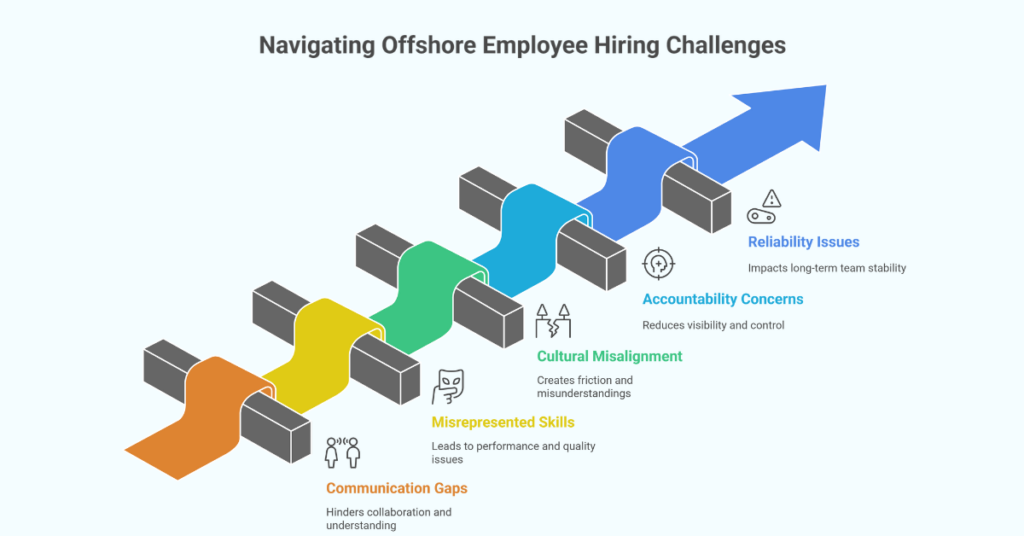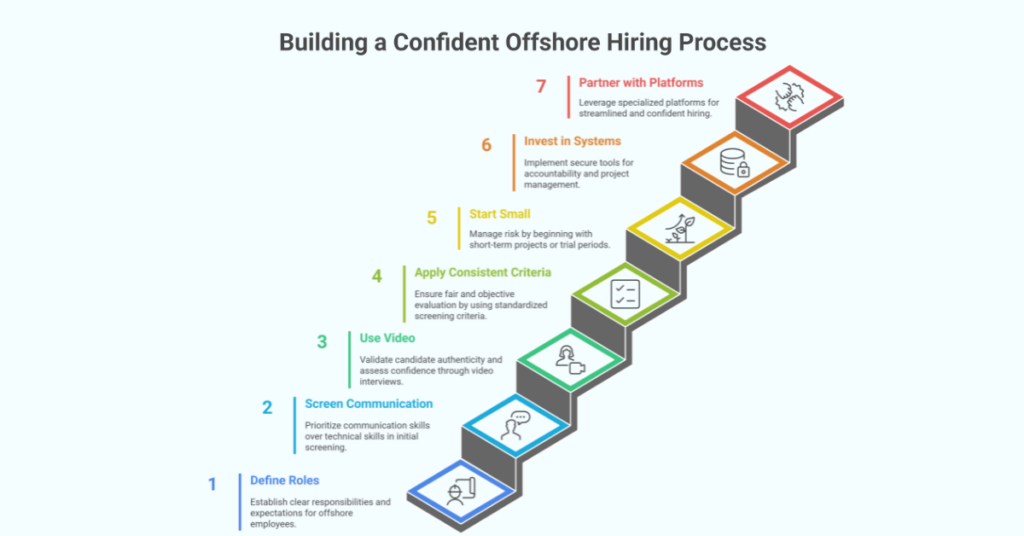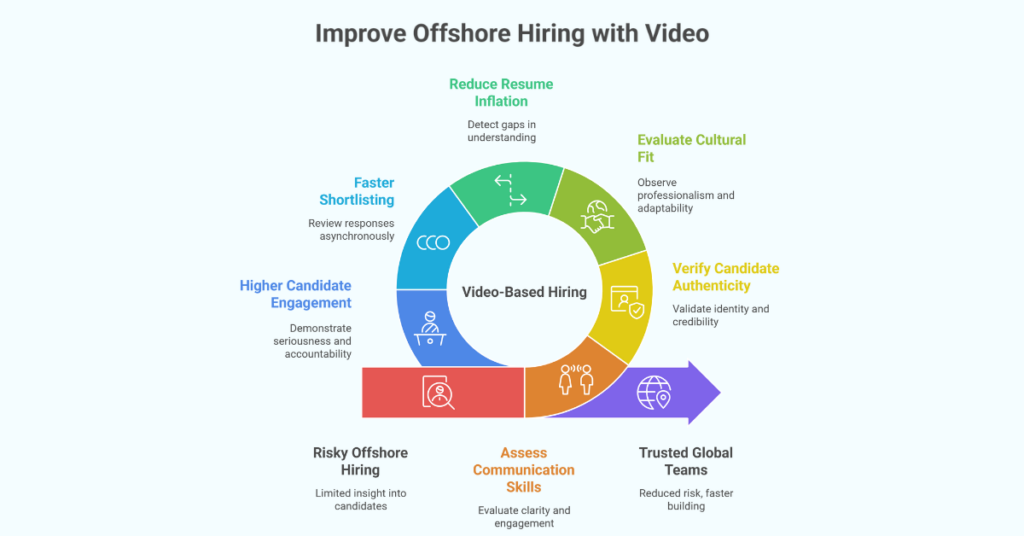“Hire Remote Workers to unlock global expertise, boost productivity, and achieve greater flexibility for your business.”
As organizations embrace digital transformation, hiring remote workers has become essential for staying agile and competitive. By 2025, it is projected that over 30 percent of the global workforce will work remotely at least part of the time, driven by advances in collaboration tools and shifting employee expectations. However, mastering remote hiring involves more than posting jobs online. Companies must cultivate a remote-first culture, create compelling job descriptions, source talent from around the world, and refine virtual interview techniques. Once hired, these employees must be onboarded with care to ensure they integrate seamlessly into your team. This guide provides a comprehensive seven-step blueprint—spanning culture definition through retention strategies—to help you attract, hire, and retain top global talent.
The Remote Hiring Blueprint: Your 7-Step Strategy
1. Define Your Remote-First Culture
Building a strong culture sets the foundation for successful remote teams and fosters trust, autonomy, and engagement.
Build Trust
Establish transparent communication channels and clear expectations so every team member knows their responsibilities. Share project roadmaps, performance metrics, and decision-making processes openly to demonstrate mutual respect. Encourage managers to check in regularly and offer constructive feedback. Trust grows when remote workers feel informed, supported, and empowered to take ownership of their work without constant supervision.
Promote Autonomy
Empower employees to design their schedules and workspaces to maximize productivity. Provide training on time management and goal-setting to help individuals plan tasks effectively. Encourage self-directed problem-solving and decision-making by granting access to necessary resources and information. Autonomy fosters innovation as employees experiment with new approaches and assume accountability for outcomes, driving higher engagement and job satisfaction.
Implement Communication Tools
Select reliable collaboration platforms—such as Slack, Zoom, and Asana—to support synchronous and asynchronous teamwork. Ensure all team members receive comprehensive training on these tools to avoid technical barriers. Standardize protocols for message response times, status updates, and meeting etiquettes. Consistent use of communication tools reduces misunderstandings, maintains alignment across time zones, and builds a cohesive remote environment.
2. Crafting Irresistible Remote Job Descriptions
A well-crafted job description attracts qualified remote workers by clearly outlining role expectations and benefits.
Highlight Flexibility
Emphasize options for flexible work hours and location independence to appeal to candidates seeking work-life balance. Describe any asynchronous collaboration practices and core hours requirements. Showcase success stories of employees managing personal commitments alongside professional goals. Flexibility not only enhances recruitment but also boosts long-term retention by accommodating diverse lifestyles.
Show Global Impact
Clarify how each role contributes to company-wide objectives and global initiatives. Illustrate cross-functional collaboration and project reach across regions. Use specific examples—such as campaigns launched in multiple markets or product features adopted worldwide—to demonstrate scale. A sense of global impact resonates with purpose-driven professionals who seek meaningful remote roles.
Emphasize Autonomy
Detail the degree of decision-making responsibility and innovation freedom candidates will enjoy. Outline approval processes and mentorship structures that support candidate growth without micromanagement. Stress opportunities for independent project leadership and creative problem-solving. Autonomy signals trust and positions your company as a progressive, employee-centric workplace.
3. Sourcing Strategies for a Borderless Talent Pool
Effective sourcing expands your search to uncover exceptional remote candidates across the globe.
Specialized Platforms
Leverage niche job boards tailored to remote work—featuring pre-vetted talent in tech, marketing, design, and customer support. Use advanced filters for skillset, time-zone alignment, and project experience. Partnering with platforms that verify candidate backgrounds and performance history reduces screening time. Regularly refresh postings and premium listings to maintain visibility among active job seekers.
Professional Networks
Engage with online communities on LinkedIn, GitHub, and industry-specific forums to identify top performers. Participate in virtual conferences, webinars, and hackathons to scout talent and showcase your employer brand. Encourage employee referrals through incentive programs and social sharing. Building relationships in professional networks uncovers passive candidates who may not be actively job hunting but possess in-demand skills.
4. Streamlining Your Remote Interview Process
A structured virtual interview process ensures you assess both technical competencies and remote-work readiness efficiently.
Virtual Interview Best Practices
Create a standardized interview schedule with clear agendas and question rubrics to ensure consistency. Use a mix of video calls, coding challenges, and situational exercises to evaluate different skill sets. Test candidate connectivity and tool proficiency beforehand to prevent disruptions. Debrief with interview panel members immediately after each session to consolidate feedback and reduce bias.
Technical Assessments
Design role-specific assessments—such as live coding, writing samples, or design briefs—that reflect day-to-day tasks. Provide detailed instructions and realistic deadlines to simulate real working conditions. Offer paid trial projects for complex or strategic roles to validate candidate performance under actual project parameters. Transparent assessment processes attract serious candidates and improve hiring accuracy.
Cultural Fit Checks
Discuss company values, team rituals, and communication norms during interviews to gauge alignment. Ask candidates to share past remote successes and challenges, exploring their strategies for collaboration and conflict resolution. Use scenario-based questions to evaluate adaptability, empathy, and proactive communication skills. Cultural alignment is critical for fostering long-term engagement and cohesive distributed teams.
5. The Art of Remote Offer and Negotiation
Crafting compelling offers ensures you secure top remote workers while respecting regional expectations.
Tailored Compensation Packages
Benchmark salaries against global data sources and adjust for cost-of-living differences. Include stipends for home-office setup, coworking memberships, and internet reimbursements. Offer performance-based bonuses and equity options to align incentives. Transparent salary ranges and benefits details signal fairness and build trust during negotiations.
Comprehensive Benefits
Extend benefits that support well-being and productivity—such as health insurance, mental health resources, and learning budgets. Provide stipends for ergonomic equipment or wellness subscriptions. Implement flexible leave policies that accommodate cultural and regional practices. A robust benefits package demonstrates your commitment to employee care and differentiates you from other remote employers.
Clear Contract Terms
Draft contracts that outline payment schedules, deliverables, confidentiality clauses, and termination procedures. Ensure compliance with local labor laws and tax regulations by consulting legal experts. Use a centralized contract-management platform to streamline approvals and digital signatures. Clarity in contract terms prevents misunderstandings and fosters a professional employer-employee relationship.
6. Onboarding Remote Employees for Day One Success
A structured onboarding process accelerates new hires’ integration and productivity from the start.
Virtual Onboarding Checklist
Develop a detailed checklist covering account setup, tool access, policy acknowledgments, and team introductions. Schedule a welcome session to review company history, culture, and organizational structure. Assign a dedicated onboarding buddy to guide the new hire through their first two weeks. A repeatable checklist ensures consistency and reduces administrative oversight.
Tech Setup
Ship preconfigured hardware—laptop, monitor, accessories—and ensure software licenses are installed before day one. Provide step-by-step guides for tool login, VPN access, and security protocols. Offer live IT support sessions to resolve any technical issues promptly. An optimized tech setup minimizes downtime and helps new hires focus on their core responsibilities immediately.
Initial Team Integration
Plan a series of short meet-and-greet video calls with team members and cross-functional partners. Use icebreakers and informal virtual coffee chats to build rapport. Establish a 30-60-90 day plan with individual goals, training milestones, and check-in points. Early engagement activities accelerate relationship-building and foster a sense of belonging in a distributed team.
7. Retaining Your Remote Stars: Strategies for Engagement & Growth
Long-term retention hinges on continuous development, feedback, and community-building.
Continuous Learning
Offer regular training sessions, webinars, and access to online courses to support skill advancement. Create personalized development plans aligned with career aspirations. Encourage knowledge sharing through internal lunch-and-learns and mentorship programs. Ongoing learning demonstrates investment in employee growth and enhances retention.
Feedback Loops
Implement monthly one-on-ones, quarterly performance reviews, and anonymous pulse surveys to surface insights. Provide actionable feedback and recognize achievements publicly to reinforce positive behaviors. Use feedback data to refine processes, address concerns, and celebrate team milestones. An open feedback culture fosters trust and drives continuous improvement.
Virtual Team-Building
Organize recurring social events—such as game nights, wellness challenges, and virtual hackathons—to foster camaraderie. Leverage collaborative projects that pair employees across regions to develop cross-cultural bonds. Encourage peer recognition programs and digital appreciation walls. Engaging activities cultivate a strong team spirit and mitigate isolation in remote settings.
How Remote Recruit Supports Your Remote Hiring
Remote Recruit empowers employers to hire remote workers with unmatched speed and precision. Our AI-driven platform sources pre-vetted candidates from over 60 countries, matching skills, experience, and timezone preferences to your role requirements. Integrated video-resume and one-click interview tools streamline candidate evaluation, reducing time-to-hire by up to 50 percent. Automated compliance workflows handle contracts, payroll setup, and benefits administration across jurisdictions, ensuring error-free and lawful hiring. Centralized dashboards track sourcing channels, interview feedback, and onboarding progress for end-to-end visibility. Job seekers benefit from personalized job recommendations, profile analytics, and video showcases that highlight their remote-work readiness. With Remote Recruit as your partner, you gain the technology, global reach, and expert support needed to build and retain a high-performing distributed team.
Conclusion
Mastering remote hiring is vital for companies aiming to thrive in a borderless economy. By following this seven-step strategy—defining culture, crafting compelling job descriptions, sourcing globally, streamlining interviews, negotiating offers, onboarding effectively, and prioritizing retention—employers can attract top remote workers and foster a resilient workforce. Each step addresses a core challenge in the remote hiring lifecycle and provides actionable tactics to ensure success. Platforms like Remote Recruit simplify these processes with AI-driven matching, compliance automation, and integrated communication tools, enabling rapid scaling and sustained growth. As remote work continues to shape the future of talent acquisition, adopting these best practices will give your organization a competitive edge and empower you to build a dynamic, engaged global team.
Frequently Asked Questions
Q1: What are the key benefits of hiring remote workers?
Hiring remote workers grants access to a global talent pool, reduces overhead costs, boosts productivity through flexible hours, and enhances diversity—fueling innovation and growth.
Q2: How do I ensure effective communication with remote employees?
Establish standardized communication protocols, leverage collaboration tools for synchronous and asynchronous interactions, schedule regular check-ins, and foster a culture of transparency to maintain alignment.
Q3: What legal considerations are involved in hiring offshore remote workers?
Companies must comply with local labor laws, taxation requirements, and data-protection regulations. Partnering with legal experts or using compliance automation platforms helps navigate cross-border employment smoothly.
Q4: How can I assess remote candidates’ cultural fit?
Integrate behavioral and scenario-based interview questions that focus on collaboration, adaptability, and communication styles. Use virtual team interactions and pre-hire trial projects to observe real-time fit.
Q5: What strategies improve retention of remote employees?
Offer continuous learning opportunities, maintain regular feedback loops, and organize virtual team-building activities. Recognize achievements publicly and provide clear career growth paths to sustain engagement.
Ready to streamline your remote hiring journey? Sign up on Remote Recruit today to start building your global team.
